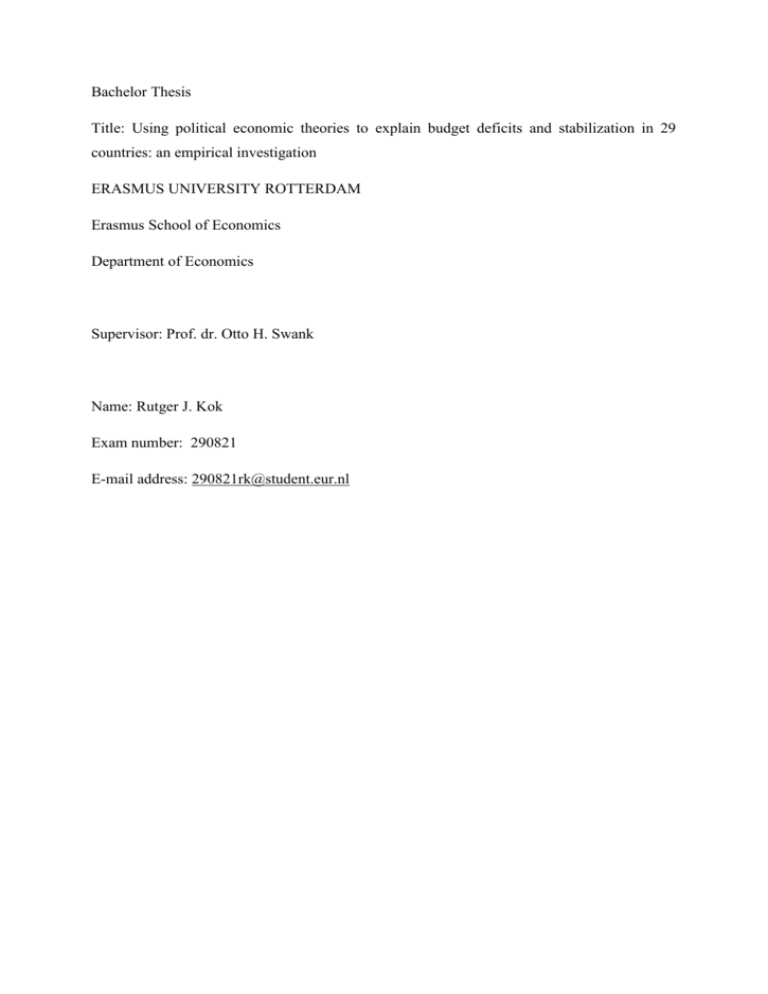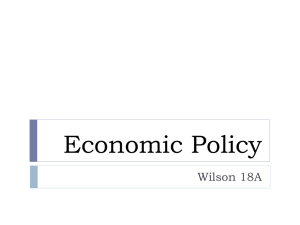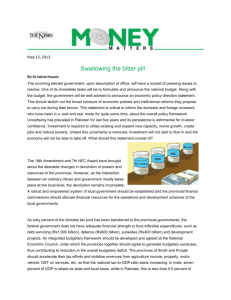Full Text (Final Version , 429kb)
advertisement

Bachelor Thesis Title: Using political economic theories to explain budget deficits and stabilization in 29 countries: an empirical investigation ERASMUS UNIVERSITY ROTTERDAM Erasmus School of Economics Department of Economics Supervisor: Prof. dr. Otto H. Swank Name: Rutger J. Kok Exam number: 290821 E-mail address: 290821rk@student.eur.nl Acknowledgements 1 Table of Contents Acknowledgements 1 Introduction 3 Theories Regarding Budget Deficits and Stabilization 5 Economic Theories on budget deficits 5 2.1.1. The Governments budget constraint 5 2.1.2 Ricardian Equivalence 7 2.1.3 Tax Smoothing 8 2.1.4 Keynes and the budget deficit 9 2.2. Budget deficits and political economics 11 2.2.1 Opportunistic Behavior 11 2.2.2. Ideological Policymakers 11 2.2.3.Debt as a strategic variable 12 2.2.4.Redistribution Conflicts 12 2.2.5.Conflicts among political parties 12 2.2.5. Geographically Dispersed interests 14 2.2.6. Effects of budgetary institutions 14 2.3. Delayed Stabilization 15 3. Methodology 16 4. Data 18 5. Results 20 5.1. Type of Government 21 5.2. Number of parties and number of cabinet members 22 6. Conclusions 23 References 25 Appendix A Appendix B Appendix C 2 1.Introduction Budget deficits among most western industrialized countries have been widespread in the last 4 years in response to the financial crisis that started in 2008. In 2010, only Norway has a (forecasted) budget surplus, out of a sample of 29 western countries1. Standard economic theories regarding a government’s budget deficit predict an increase in deficits during lower economic growth and a decrease in deficits during higher economic growth. Theories such as ‘tax smoothing’ developed by Barro (1979) or the role of the government in a Keynesian view indeed explain why deficits have risen during the last years. What these theories can’t explain are the huge differences in budget deficits and accumulated debt among countries with similar growth patterns and countries facing a similar crisis. In 2010 for example Japan faces a budget deficit of 7.6% of GDP, while Norway has a surplus of an astonishing 9.6%. Italy’s net debt will reach 120% of GDP in 2015, while Canada will have a stable debt of around 30%. Since the budgets are determined by politicians and economic theories cannot explain these differences in debt accumulation and deficits, economist have entered the field of politics to try to explain these differences. Among the first were Roubini and Sachs (1989), who empirically tried to explain these differences using all sorts of different political variables. Grilli et al. (1991) tried to link economic variables to the type of government, using theories based on, among others, Alesina and Drazen (1991). Using their model of a war of attrition among decision makers, Grilli proposed a weak government theory. The theory states that governments consisting of multiple parties (coalitions) would have more difficulty reaching agreement on tough budget cuts to reduce deficits than governments consisting of single party majority governments. Empirical analysis of their ‘weak government’ theory gave mixed results at best, as did most analysis to follow. In this thesis I will try to link differences in budget deficits between 29 countries in a new OECD dataset for the period 2007 until 2010 using political indicators of the type of government, number of parties in government and number of cabinet members. My main hypothesis is therefore: Ho: Budget surpluses and stabilizations of budget deficits in 29 countries are not influenced by political variables describing the type of government and the number of parties and ministers in governments. 1 See Appendix A, variable NGL 2010. 3 Ha: Budget surpluses and stabilizations of budget deficits in 29 countries are influenced by political variables describing the type of government and the number of parties and ministers in governments. By using an ordinary least squares regression, will try to estimate the coefficients linking the type of government, described as either minority, coalition of majority, to the budget deficits in 2007, 2008, 2009 and 2010. As explanatory variables I will also use the number of parties in government and the number of ministers in a government. I will also try to estimate the influence of these explanatory variables on the stabilization of budget deficits by comparing the average of the deficits of 2007 and 2008 with the average of the deficits of 2009 and 2010 to see how countries with different types of government characteristics react to a crisis and its budgetary implications. My conclusion is that there is not a clear influence of the political variables on the budget deficits in my dataset. The results are either of the wrong sign to be in accordance with theories like that of the weak government, or are not significant enough to draw conclusions upon. If they support any theories, it are those of Crepaz (1996) and Lijphart (1999) favoring coalition governments to minority of majority governments in that they are better able to cut budget deficits. My thesis is structured as follows: in section 2.1 I will give a review on the economic definition of budget deficits and I will explain the government’s budget constraint, including relevant theories such as Ricardian equivalence and tax smoothing. Section 2.2 will further explain budget deficits by including political economic theories regarding budget deficits. Section 2.3 contains the delayed stabilization theory of Alesina and Drazen (1991) Section 3 will then shortly describe the methodology used in my research. Section 4 contains a description of the dataset I have used and section 5 includes the results obtained. I will then report my conclusions in section 6. 4 2. Theories regarding budget deficits and stabilization 2.1. Economic Theory on Budget Deficits 2.1.1.The Government’s Budget Constraint Governments collect taxes or issue bonds to ‘produce’ public goods that civilians, or private agents, themselves wouldn’t produce, like education, national defense, social benefit schemes etc. This implies that they also have a budget constraint like the households they serve. Basic macroeconomics2 tells us that the government’s budget constraint in a two period model is: (1) So the present value of government’s spending G in the two periods should equal the present value of government’s income T. To expand it to an infinite time period and to make it more realistic, the government should also be able to issue debt D. The constraint should also include all discounted values of all future tax income, government’s expenditures and future rent payments on the debt. The present discounted value of a continuous income stream of a rate f (t) per unit t, with continuously compounded interest at rate r per unit t over a time interval of [0, ] is given by: (2) Since the real interest rate r the government faces may vary over time, we need to account for this in our function. Thus we state that3: (3) Now it is possible to adjust (1) to a multi period model (towards infinity) and state that the present discounted value of all future expenditures G(t) must equal the initial debt D(0) plus 2 Derived from Burda and Wyplosz 2001, Romer 2006. 3 R(t) is defined as to account for the fact that the real interest rate r may vary over time. Discounted back to time 0 gives the present value of 1 unit at time t is . If for example r is constant at level z at all time, R(t) is simply zt and . 5 the discounted value of all future income T(t). The government’s budget constraint is therefore: (4) To describe the limit of debt, rewrite (4) to a limit. I first bring both integrals to the same side and combine them to get: (5) Since by definition: (6) Writing (4) as a limit gives: (7) Now consider debt at point t=s, D(s): (8) Looking closer at (8) reveals that it is the same as the part in brackets in (7) times , with the first term representing the initial real debt issued until s and the second term what has been added to it from t to s. Using (6) again we can now state that (4) is equal to: (9) So the limit of the present value of the government debt can never be positive. This shows two important things: if the real interest rate is always positive, a positive but constant debt satisfies the government’s budget constraint, implying that the government has the possibility to never pay off his debt. Second, even if the debt is growing each time sequence, it is still within the government’s budget constraint if the real interest rate is higher than the debt growth rate. So (4) gives the government the possibility to stay in debt forever and to let the debt increase forever, as long as the debt remains sustainable. 6 Government debt is not the same as a government’s budget deficit. A simple definition of the budget deficit is the change in the government’s real debt in a time period, or: (10) Where the term in brackets on the right hand side represents the so-called primary deficit and the other part of the government deficit is formed by rent payments on the outstanding debt. Although the budget constraint (1) and the budget deficit (3) look closely related, it is easily shown that one can be affected without changing the other. A conventional method of displaying a countries deficit is in nominal terms. A change in nominal debt B is: (11) where P is the price level or inflation and i is the nominal interest rate. If P rises, interest rate i rises too, since it is linked to a given real interest rate, and so interest payments increase and so will the deficit. But because of higher inflation, the real value of debt is falling and the effect of higher interest payments just offsets the lower debt, so the government’s (real) budget constraint is not affected while the deficit has increased. This clear lack of connection between the deficit and debt gives governments the opportunity to satisfy deficit goals set by parliaments while not reducing the debt4. 2.1.2 Ricardian Equivalence Does it matter for an economy if governments use bonds (and raise debt) to satisfy their budget constraint or raise taxes? Barro (1974) argued that there is no difference for households if they are faced with the present value of future taxes, or with buying debt now and receiving rent. Only the quantity of government purchases is relevant to the economy. This result is called Ricardian Equivalence5. Consider a household buying bonds D at time and a government retiring the bond D at the household D at at including rent r. The government then has to tax . The household now has an asset with net present value of and a liability with a net present value of D at . It is assumed that a household spreads consumption according to the permanent-income hypothesis6. In short, the permanent-income hypothesis states that consumers will base their spending not just on 4 See Romer 2006 for more examples concerning the lack of relationship between government deficit and debt. See Barro 1974 and Barro 1989 for formal proof, it is beyond the scoop of this thesis to include this, therefore I will only explain the theory with a simple example. Also have a look at O’Driscoll 1977 for a discussion on whether or not it should be called ‘Ricardian’ Equivalence. 6 See Friedman (1959) for a full description of the permanent income hypothesis. 5 7 current income, but on all future income streams. This implies that the household’s net wealth does not change and therefore the households consumption behavior does not change. Although this result looks simple and straightforward, it has great implications for policy making. In traditional economics, a shift from tax to bond financing increases consumption, because consumption only depends on disposable income, which is income minus taxes or YT. This implies that a country can increase consumption by cutting taxes and financing it by issuing bonds. But if Ricardian equivalence holds, this does not make a difference. Ricardian equivalence would also make efforts by countries to cut taxes during recessions futile, since households expect taxes to raise afterwards. Ricardian equivalence is still debated. There are some reasons why Ricardian equivalence would not hold. One would be the turnover of population. Since it is not the same population holding debt and paying taxes because of a limited lifespan, the population does not expect to pay the taxes associated with a rise in debt and therefore does increase consumption when taxes are replaced by bonds (tax cuts). Another could be the fact that Ricardian equivalence is build on the permanent-income hypothesis. For Ricardian equivalence, this implies that consumers will not spend more today if they receive a tax cut if they know they will be facing higher taxes in the future. But liquidity constraints, a pre-cautionary saving motive or impatience can cause a departure from the permanent-income hypothesis. Some empirical analyses have also shown that permanent income does not always hold7. 2.1.3 Tax Smoothing Barro has further applied the Ricardian equivalence theorem to explain debt levels of the government.8 His theory states that the government, viewed as a ‘benevolent social planner’9, has to finance government spending through taxes on labor income. But taxes cause distortions in the economy because they affect labor supply. The government should spend just enough to offset the marginal distortions, or excess burden, caused by the last dollar of collected tax. The role of public debt is thus to smooth the tax distortions over time. A government is judged by the electorate and the electorate expects smooth consumption of public goods10. This calls for issuing debt when revenues fall or expenditures rise and when tax revenues drop in the long run, the tax rate should instantaneously rise. Tax smoothing also 7 See for example Campbell, Mankiw (1990) See Barro 1979 and Lucas and Stokey 1983 9 Citated from A Positive Theory of Fiscal Deficits and Government Debt, Alberto Alesina and Guido Tabellini, The Review of Economic Studies, Vol. 57, No. 3 (Jul., 1990), p 403 10 Follows from the permanent income hypothesis, see Friedman (1959) 8 8 calls for a ban on postponing unpopular policies like raising taxes or cutting expenditures, because this only leads to higher and more unpopular measures afterwards. As we will later see, politicians do not use this rule as their guide in forming policy. 2.1.4 Keynes and the budget deficit Why do countries run deficits and how can they be reduced (and countries’ debt levels) ? Since deficits and debt are usually expressed as a percentage of GDP, there are three ways to reduce (enlarge) deficits (surpluses): by raising taxes, by lowering government expenditure and, because it is expressed as a percentage of GDP, by raising GDP. But there are several other ways to reduce deficits. To be able to explain these other ways, I will give a brief review of the Keynesian view of an economy11 and I will explain why countries run deficits. In a simple Keynesian model, output is determined by aggregate demand, because of price rigidity and excess capacity (an output gap). Aggregate demand consist of public and private spending. If there is an exogenous shock, governments can boost public spending and so get the aggregate demand up at the trend level of output with the cost of running a deficit. Another reason to run deficits is unemployment. Unemployment rises when a country is in a recession. When unemployment rises for the long term, fiscal policy is useless, because the equilibrium unemployment has shifted. But when there are short run fluctuations around the long term equilibrium because prices and wages are too rigid, fiscal policy can help. This is called countercyclical fiscal policy. Fiscal policy can also be seen as an automatic stabilizer. When an economy slides into recession, taxes will drop and spending, because of social security schemes etc., will rise. This is an implicit form of expansionary fiscal policy. The government’s budget thus acts as an automatic stabilizer to counter negative business cycles. So budget deficits are seen as a necessary evil, because of their stabilizing function on the economy. But how can the budget itself be stabilized? Besides cutting the deficit via fiscal policy, other measures are seigniorage and inflationary tax. Because these are not relevant for 11 See Keynes 1936 for a thorough explanation. 9 my research, I will not discuss them further. Motives for delayed stabilization will be discussed later. In figure 1 on the next page budget surpluses are presented in the graph as net government lending as a percentage of gross domestic product (GDP, or (Y) in this equation), so they are derived by: (12) Figure 1. Source: IMF, World Economic Outlook Database, June 2010 It appears that some countries can keep running deficits for a long period of time, especially Japan and Italy. In figure 2 the net government debt of six countries is pictured as a percentage of GDP. It becomes apparent that all these countries have huge debts, and that only Canada has reduced its debt since the 1990’s. Figure 2. 10 Source: IMF, World Economic Outlook Database, June 2010 The tax smoothing theory cannot answer questions like why there are differences in deficits and debt between countries with similar growth patterns and why countries keep accumulating debt12. The field of political economics investigates, among other areas, possible political explanations for budget deficits. I will discuss the most relevant below. 2.2 Budget Deficits and political economics To describe the political economic models I will follow the same structuring as Alesina and Perotti (1995) and Pinho (2004), which is viewing the models as deviations of the tax smoothing theory and grouping them accordingly. To stay within in the focus of my research I will discuss certain models very briefly and other more relevant models more extensively. 2.2.1 Opportunistic behavior Models based upon opportunistic behavior assume that voters do not take the government’s budget constraint as in (4), that is they overestimate the benefits of running a deficit and underestimate the future tax burden. This is called the fiscal illusion. Politicians exploit this myopia of voters by using budget deficits to increase their chances of being reelected. Nordhaus (1975) first presented this as the political business cycle. That is, governments run bigger deficits prior to elections than after them. The main criticism on this approach is that it 12 See for example Grilli et al. 1991 for convincing data and longer time series on why tax smoothing and shock absorbing cannot fully explain these differences. Alesina and Perotti (1995) consider tax smoothing a valid normative theory of budget deficits but it lacks as a positive theory. 11 assumes a systematic bias in voter’s errors and that it does not explain the differences in cross-county deficits and debt accumulation. 2.2.2 Ideological Policy makers Hibbs (1986) developed the theory of partisan cycles. This states that there are two types of policy makers, left winged and right winged, both maximizing the utility of their respective voters. Leftwing voters are dependent on labor as income and thus more concerned about unemployment, while the rightwing voters are dependent on capital income and more concerned about inflation. Although this theory could help explain cross-country differences, it does not explain debt accumulation. 2.2.3 Debt as a strategic variable Models that can explain debt accumulation are models using debt as a strategic variable. I will discuss two approaches. Alesina and Tabellini (1990) discuss a two-party system with the parties differing on how to spend their resources. As one party, say party A, is acting as government, and it knows that party B will form the next government, it will borrow as much as possible to maximize its utility and to minimize the abilities of B to spend taxes on issues they prefer when B has control, because B will have to use all tax income to pay off the debt. So the more polarized society is and the more unlikely it is that the governing party is reelected, the higher the deficit and debt will be. Persson and Svensson (1989) found that spending and borrowing huge amounts is not realistic. Their model consists of a conservative party, A, wanting to cut spending more than liberal/leftwing party, B, wanting to run surpluses. If A is the ruling party and it knows it will be replaced by B it can cut taxes and/or issue debt to limit B’s spending abilities and keep future spending lower. But when A is in office it will run opposite policy, creating the same inefficient policy as in the first model. Main problem of these models is that the future government in reality has the option of default. The current government is then limited to issue just so much debt that the future government is indifferent between defaulting and repaying the debt, but this doesn’t look like a realistic assumption. 12 2.2.4 Redistribution Conflicts Redistribution conflicts arise when one generation leaves debt for the next generation. A selfish generation could shift the tax burden to the future but because of intergenerational altruism this behavior is limited. There are various models13 describing redistribution conflicts, but since it is not relevant for my research I will not discuss these here. 2.2.5 Conflicts among political parties One of the basic results of game theory is that cooperation among agents is more difficult when there are more agents. Relating this view to economic policy making by different parties in government suggests that it will be difficult to cut spending or raise taxes to reduce deficits if there are more decision makers. Roubini and Sachs (1989) have argued that countries with multiparty coalitions tend to have more difficulty reaching consensus on how to cut deficits because of the veto-power each coalition member has to block budgetary decisions which would have a negative impact on their voters. Coalition members also tend to have difficulty implementing their own plans because of veto power. They also know the electorate has difficulty distinguishing between which policy is implemented by which party, causing a lack of monitoring and thus higher deficits. Also linking the number of parties to a country’s debt is a theory put forward by Kontopoulos and Perotti (1999). They argue that government spending might increase in the number of coalition parties and they base that largely on the common-pool problem. The common-pool problem is a situation where the benefits of economic policy are given to a relatively small group, while the taxes are shared by everyone. Because of this, people have an incentive to try to get more of the government spending because they do not fully internalize the cost. This causes too much spending and thus deficits. Because coalition governments by definition consist of more parties than majority (single party) governments, and these are also more likely to be representational regimes, they tend to lead to higher government spending. Closely related to this argument is the political stability of a government. If we define political instability as how long a coalition stays in government, game theory suggests that when we view economic policy making as a decision making game, governments with shorter tenure will have a smaller chance of playing repeated-decision making games. Since having 13 See for example Cukierman and Meltzer (1989) for a model of rich vs poor parents. Also look at Persson and Tabellini (1999) describing 6 types of redistributional conflicts. 13 less opportunities of implementing policy a party prefers, stabilization is delayed. In this model it is not the amount of parties in government causing deficits but its tenure in government. Alesina and Drazen (1991) proposed a model where stabilizations are delayed because of a so-called ‘war of attrition’. See section 2.3 for a description of their model of delayed stabilization. Another concept which could explain why governments differ in their deficits is government weakness. A strong government is able to reduce deficits faster than weaker governments because of broader support of the electorate. Grilli, Masciandaro and Tabellini (1991) determined government weakness in terms of the type of government (TOG). They defined three types of government, minority, coalition and majority with majority being the strongest and minority the weakest. From their sample of 18 OECD countries they got mixed results as to whether weaker governments run higher deficits14. They did find significant results when they used the governments durability as explanatory variable. They defined durability as the number of days between elections. But it is difficult to state if the effect they found can be contributed to a weaker government or to political instability. Main criticism is that most of these arguments could also be changed to make coalition governments more decisive and fiscally responsible than single-party governments. Crepaz (1996) for example states that in countries with single party governments, policy switches every term between the two or three largest parties, undoing the reforms the former governments implemented. Coalition governments would then be better for continuity and would be more committed to responsible fiscal behavior because of the probability that some of the coalition parties could be in the future government. Lijphart (1999) adds that policy that has a broad consensus in a society has a bigger probability of being successfully implemented, assuming that coalition governments have bigger support15. 2.2.5 Geographically dispersed interests If central governments collect taxes but local authorities spend most of the budget, local authorities could not fully internalize the costs they make and thus increase spending. This argument is similar to the common pool problem and has been elaborated by Alesina et al 1997, but has not been properly investigated because of the difficulties of collecting data. 14 Roubini, Sachs (1989), Edin, Ohlsson (1991), Grilli et al. (1991) and Blais et al (1993) found results confirming the weak government hypothesis, but not overall significant. 15 Crepaz (1996) and Lijphart (1999) therefore reached the opposite conclusion of Grilli et al. (1991): weaker governments have ‘better’ economic and fiscal policy. Sakamoto (2001 and 2005) also had mixed results. 14 2.2.6 Effects of Budgetary institutions Since models of conflicts and voting behavior do not account for all cross-country differences, institutional variables could be included to account for differences in a country’s budgetary procedures and main institutional framework. Budget deficits are widely believed to be more apparent in parliamentary regimes than in presidential regimes 16. Or, put another way, parliamentary regimes are believed to be the cause of a bigger government. Whatever constitutional system a nation has, it involves a tradeoff between accountability and representation. When a country chooses it’s president directly, he can be held accountable for his policy in person. But choosing a president also makes it less probable that the government is a good representation of the electorate. With a parliamentary regime and the higher chance of coalition (minority or majority) governing, the accountability drops but the representation rises. Consequence of this representational difference is that in parliamentary regimes, because of the majority structure, the interests of more voters are looked after, causing more schemes designed at benefitting more voters, while in presidential regimes programs are targeted at a more specific group of voters at the cost of the broader spending programs, hence lower spending17. 2.3. Delayed Stabilization Alesina and Drazen (1991) created a model where deficits can persist because of distributional conflicts between parties in government. Their model reasons as follows: when there are 2 parties or agents with different preferences regarding to where reform should take place, they show that each party will continue to bargain as long as the cost of delay (the rise of the budget deficit and inflation) is less than the cost for their constituents. They signal to the other party that they prefer to remain in the status quo situation of a budget deficit than to accept reforms that give their voters a larger share in the excess burden that is associated with reforms. Their expected value of outcome is then higher when they delay stabilization while it is clear that both parties could also induces strategies making them both better off 18. For example Grilli et al (1991) use their model of a war of attrition to show that governments consisting of multiple parties will have more difficulty balancing the budget than ‘stronger’ 16 See Persson and Tabellini 2003 for an empirical test of constitutional effects on economic policy. For more on institutional effects and the effects that arise from the constitutional framework of a country, again look at Persson and Tabellini (2003) 18 See Hsieh (2000) for a model on labor strikes with similar conclusions. Also look at Martinelli and Escorza (2005) who show that when there is asymmetric information about the costs of reform ex ante, the delay will be shorter. 17 15 governments. Romer (2006) justifiably points out that the model of Alesina and Drazen does not explain why certain type of governments run deficits, but only that stabilization of these deficits and of public finance in general will be delayed when faced with multiple parties bargaining. 16 3. Methodology My main hypothesis of this thesis is: Ho: Budget surpluses and stabilizations of budget deficits in 29 countries are not influenced by political variables describing the type of government and the number of parties and ministers in governments. Ha: Budget surpluses and stabilizations of budget deficits in 29 countries are influenced by political variables describing the type of government and the number of parties and ministers in governments Following Grilli et al. (1991), I will use a method of ordinary least squares (OLS) to describe the relationship between economic variables and political variables. This means that all of my results will be of the form: Where Y is the response variable, C is a constant and [X1,Xn] are explanatory variables. As response variables I have constructed the economic variables NGL 2007, NGL 2008, NGL 2009, NGL 2010 from data described in section 4, to represent a country’s budget surplus. These are budget surpluses as a percentage of GDP. I have also constructed variables NGL0708 and NGL0910. These are the average surpluses of 2007 plus 2008 and 2009 plus 2010 respectively. Subtracting these from each other gives NGLSTABLZ, a measure for stabilizing behavior. I have used a sample of 29 countries all with democratic constitutions. To correct for deficits declining because of GDP growth as described in section 2.1.4, I also include GDP growth in percentages lagged one year as explanatory variable in some models. My political explanatory variables for the type of government are MINORITY, COALITION and MAJORITY. These are dummy variables. I coded them 1 if a country has the corresponding type of government in 2008 and 0 if not. Other political explanatory variables are PARTY08, CAB08, PARTYAVE and CABAVE. These variables are the number of parties in the government in 2008, number of members of cabinet in 2008, number of parties in government on average between 2004 and 2008 and the number of members in cabinet on average between 2004 and 2008 respectively. 17 If GDP grows, a countries budget deficit is expected to decline as explained above. Therefore I expect GDP to enter my model with a coefficient with a negative sign. If a country has a minority or coalition government, following theories elaborated in section 2.2 such as the weak government theory by Grilli et al. (1991), I expect a country to have a bigger deficit when it has either a minority government or coalition government than when it has a majority government. Therefore MINORITY and COALITION should have a more negative coefficient than MAJORITY. If the number of parties in government rises I expect a country to run a higher deficit following the theories described in section 2.2 and the delayed stabilization theory in section 2.3. Therefore I expect PARTY08 and PARTYAVE to have a coefficient with a negative sign. The same reasoning applies to CAB08 and CABAVE. I thus also expect that this variable enters negatively in my estimation. I do expect to see more clear results for number of party members than for number of cabinet members, because different cabinet members from the same party should logically hold the same interests as they represent the same constituents. This should give less cause to a war of attrition as modeled in section 2.3. Like most research in this area, it is not my goal to specifically give exact predictions of what budget deficits will look like given certain government characteristics. I will only try to show some stylized facts from the data and then informally try to link these to the theories described in section 2. 18 4. Data For the economic variables I used a new dataset from the OECD Economic Outlook June 201019 covering 29 countries. I chose these countries because they have, on average, similar growth patterns and are democratic countries, thus effects of political variables should according to theory account for the differences in budget surplus. For an approximation of the budget surplus I have taken the net government lending (NGL) data from 2007 until 2010 of these countries20. Net government lending is the amount a government lends via bond issuing as a percentage of GDP. Although I am fully aware that this is not the same as a countries primary deficit/surplus, the lack of other recent data left me no other choice. Comparing NGL to available primary deficit data shows that these are quite similar. From these data I have constructed seven NGL variables (NGL2007, NGL2008, NGL2009, NGL2010, NGL0708, NGL0910) representing NGL in the respective years and an average for 2007-2008 and 2009-2010, representing pre-crisis and post-crisis average surpluses. Subtracting NGL0708 from NGL0910 gives NGLSTABLZ, a measure for stabilization. It are budget surpluses because when NGL is negative, the government borrows money and thus runs a deficit. I also used the GDP growth data from the same source. I then used an ordinary least squares method to estimate the effect of political variables. All data from the political variables are from the Political Data 21 sets, written by different authors each year for the European Consortium of Political Research. Three of these variables represent the type of government (TOG). I have defined 3 types: MINORITY, COALITION and MAJORITY, each type representing the TOG in 2008. Because of simplicity I only used the TOG of 2008 because these are on average the most consistent with the TOG of the last 5 years22. Also, since my economic data also includes 2009 and 2010 and there are no data available yet of the TOG of these years, 2008 gives the best approximation. 19 Data is accessible via the OECD website at: http://www.sourceoecd.org/database/OECDStat and summarized in Appendix A 20 These are: Australia, Austria, Belgium, Canada, Czech Republic, Denmark, Estonia, Finland, France, Germany, Greece, Hungary, Iceland, Ireland, Israel, Italy, Japan, Luxembourg, The Netherlands, New Zealand, Norway, Poland, Portugal, Slovakia, Slovenia, Spain, Sweden, Switzerland and the United Kingdom. 21 These include Political Data in 2004, 2005, 2006, 2007 and 2008. Since every issue is released in December of the following year, the most recent available edition is 2008. 22 See Appendix B for data 19 I followed the coding used in the Political Data 2008 concerning the majority status of a government, but changed it slightly because they use 5 levels and my dataset is too small to use 5 different levels23. The other two political variables are the number of parties in the government in 2008 (PARTY08) and the number of cabinet members in 2008 (CAB08). I also used and average of 2004, 2005, 2006, 2007 and 2008 to construct PARTYAVE and CABAVE, the average number of parties in government and members of cabinet respectively. In the appendix all data are included. In appendix A, data are displayed in figures to look for extreme values. In NGL2007, NGL2008, NGL2009 and NGL 2010, Norway appears to have an extremely high surplus compared to other countries in my sample as also mentioned in my introduction. I will therefore also run an OLS regression considering Norway an outlier and therefore omitting it of the data. The main trend is downwards: as countries enter the crisis in 2007 and 2008, surpluses are roughly between [-5,6], while in 2009 and 2010 they are concentrated in [-10,0]. In figure 4, the average net government lending as % of GDP sorted by the type of government is given. This shows results not expected by the weak government theory. Countries with a minority government show an almost equal surplus/deficit as coalition run countries, and majority run governments run a substantially higher deficit. This can be easily Figure 4. 23 I altered the coding of Political Data 2008. I coded single party minority government and minority coalition as MINORITY, minimum winning coalition and oversized coalition as COALITION and single party majority government as MAJORITY, following Grilli et al. (1991) and Roubini and Sachs (1989). 20 explained by looking closer to the dataset. The majority run countries are Austria, Greece, Portugal and the United Kingdom. All these countries ran high deficits in the last 4 years and Greece was considered to be close to a default in 2010. But since Greece (and the other countries) cannot be considered as an outlier as shown in appendix A, I have no choice but to follow the data and perform my analysis as planned. I will exclude some countries to see if these effect the results, but changing the sample size by excluding countries, although possibly offering different results, will only make it more difficult to draw conclusions based on the analysis of my data. My data consist of 20 coalition countries, 5 minority countries and 4 majority countries. This implies that minority and majority data are easily influenced by individual countries. The lack of available data restricted me from adding more countries. This implies that it will be difficult to obtain conclusive empirical observations. 21 5. Results My results are all displayed in detail in Appendix C. I have used 8 different models to find an answer to my main hypothesis. I will first discuss my results regarding type of government using model 1,2,3 and 4. After that I will discuss the results regarding number of parties using model 5 and 6 and number of members of cabinet using model 7 and 8. 5.1 Type of Government Model 1 tries to give determinants of budget deficits by using Minority and Coalition as explanatory variables with the effect of majority contained in the constant. Following the theory of weak governments and others as mentioned in section 2 and 3, I expect the coefficient of Minority to be lower than Coalition to account for the fact that these have more difficulty getting a balanced budget. Although the results for NGL 2007 are overall significant, they show a result other than expected: coalitions run higher deficits than minority governments. For NGL 2008 the results are not significant (and give an almost equal coefficient for Coalition and Minority). The 2009 data, although not all significant and only explaining roughly 14% of all variance in the data, do confirm the weak government theory, with a higher coefficient for Coalition than for Minority. The results for NGL2010 and NGLSTABLZ are overall not significant and explain little variance Model 2 also incorporates GDP24 as an explanatory variable and I have excluded Norway to see if this changes the overall estimates, since Norway has an extremely high budget surplus in all years. In 2007 it does improve the results by giving a significant Constant and Minority coefficient but still Coalition enters the equation with a higher coefficient, not as expected by my weak government theory. In 2008 I also removed Iceland to see how the model reacts. It now accounts for 74% of all variance in the model, but only Coalition enters significantly. Coalition now does have a higher coefficient in accordance with the expected results. The same applies to 2009, but in these data I have excluded Ireland from the sample. Coalition now also enters the equation as expected with a higher coefficient but the model only accounts for 33% of the variance. For NGL201025 and NGLSTABLZ, although the 24 For NGL 2007, the GDP growth as a percentage of GDP of 2007 is included. For all other years, the GDP of one year earlier is included. 25 The results for 2010 are based on data excluding Ireland, the United Kingdom and Norway, but even then the results are not significant. 22 coefficients are larger for Coalition than for Minority, the results are not significant. GDP is never a significant variable but does overall have a negative coefficient but it’s effect is rather small with a coefficient ranging from -0.44 to 0.22. This could be due to the fact that the data only cover 4 year. Model 3 only has majority as explanatory variable and Model 4 also includes GDP. Majority enters negatively in all equations and thus doesn’t have the expected sign. This is as expected as explained in section 4. Even if the results are significant as in 2009, they explain little variance to regard these as good results to draw conclusions on. Overall I don’t find results showing that the type of government influences the budget deficit. If there are significant results, these are mixed, supporting the weak government theory by Grilli et al (1991) in some years, and Crepaz (1996) and Lijphart(1999) theories in other years. Most of these results are obtained by editing the dataset to exclude a country or countries with extreme values. This of course does not make my results conclusive. 5.2 Number of parties and number of cabinet members Models 5 and 6 are based on the number of parties in government. As explained in section 2, for example Alesina and Drazen (1991) suggests that when there are multiple parties negotiating on budget cuts, this will lead to a war of attrition in which it is optimal for both parties to try to keep the status quo (a budget deficit) instead of giving in to reforms harmful for their own constituents. Model 5 includes the number of parties in 2008 and model 6 includes an average of the last 5 years. The war of attrition theory suggests that this variable should have a negative sign: the more parties a government consists of, the higher the budget deficit will be. My results point in the exact opposite direction: all results are with a positive sign, indicating that the more parties a government consists of, the lower the budget deficit will be. For all years except 2010, results are either not significant or explain less than 28% of variance. Model 5 is significant in 2010 and explains nearly 80% of variance, but this again yields the result that the more parties are in a government, the lower the budget deficit. Models 7 and 8 include the number of cabinet members as explanatory variables. These models are overall not significant. Only 2010 gives a promising result for model 8, explaining 77% of variance, but the effect is very small (the coefficient for Cabave is -0.08). These results do not indicate that either number of parties nor number of cabinet members can 23 explain budget deficits. Even when excluding France and Canada with their high amount of cabinet members compared to the other countries, no significant results can be shown. For all models, NGLSTABLZ does not yield any significant results. 6. Conclusions In my thesis I empirically analyzed a dataset constructed from data from 29 countries regarding their budget surpluses, GDP growth and different government characteristics to see if budget deficits are influenced by these characteristics. I used theories regarding political determinants to validate my approach. Following, among others, Grilli et al. (1991), I used an ordinary least squares regression to try to find answers for my main hypothesis: Ho: Budget surpluses and stabilizations of budget deficits in 29 countries are not influenced by political variables describing the type of government and the number of parties and ministers in governments. Ha: Budget surpluses and stabilizations of budget deficits in 29 countries are influenced by political variables describing the type of government and the number of parties and ministers in governments. My results as summarized in section 5 do not provide results significant enough to conclude that government characteristics such as type of government, number of parties or number of cabinet members influences a country’s budget deficit. Therefore I cannot reject Ho. If the obtained results were significant, they are overall of the wrong sign or have changing signs when compared to other years. They tend to lead to theories of Crepaz (1996) and Lijphart (199) that coalition and multiparty governments cause lower deficits. But no definite conclusions can be made with the available results. Regarding the number of decision makers as defined by the number of parties, the effect is also opposite to what is expected by the war of attrition model of Alesina and Drazen (1991). Number of cabinet members never enters the regression significant as an explanatory variable. There could be several reasons why this dataset and the results obtained do not support my hypothesis. First, the data is of limited size, not regarding the amount of countries, but regarding the amount of years. For good comparative research the data should exclude budget deficits 24 caused by the automatic stabilizer effect or Keynesian stimulation policy to be able to detect other effects possibly caused by government characteristics. Second, my sample includes 20 coalition countries, 5 minority countries and 4 majority countries. This implies that data can easily be influenced by single observations, especially for majority and minority countries. I tried to exclude some countries that could be considered outliers from my analysis, but this did not lead to conclusive findings. Third, theories as stated in section 2 are still debated. It is therefore not to be expected that budget deficits can be solely explained by governments characteristics. Previous empirical work also gave mixed results as to whether and how economic policy making can be linked to government characteristics. Fourth, 25 References Alesina, A. Tabellini, G. (1990), A Positive Theory of Fiscal Deficits and Government Debt, The Review of Economic Studies, Vol. 57, No. 3 (Jul., 1990), p 403 Alesina, A. Drazen, (1991) Why stabilizations are delayed, Bale, T. van Biezen, I (2007),”Political Data in 2006”, European Journal of Political Research Bale, T. van Biezen, I (2008),”Political Data in 2007”, European Journal of Political Research Bale, T. van Biezen, I (2009),“Political Data in 2008”, European Journal of Political Research Banaian, Roberts 2008 – The design and use of political Economy Indicators Barro 1974 Barro, R.J.(1979), “On the determination of public debt”, The Journal of Political Economy, Vol. 87, No. 5, Part 1 (Oct., 1979), pp. 940-971 Barro 1986 van Biezen, I . Katz, R.S., (2005),”Political Data in 2004”, European Journal of Political research van Biezen, I. Katz, R.S., (2006),”Political Data in 2005”, European Journal of Political research Burda and Wyplosz 2001 – Macroeconomics, a european text, 3th edition Campbell, J.Y., Mankiw, NG (1990), Permanent Income, Current Income and Consumption, Journal of Business and Economic Studies, July 1990, vol. 8, no 3. pp. 265-279 Hemming, Richard, Kell, Michael and Mahfouz, Selma, The Effectiveness of Fiscal Policy in Stimulating Economic Activity: A Review of the Literature (December 2002). IMF Working Paper, Vol. , pp. 1-53, 2002. Keynes, J. M. 1936, The General Theory of Employment, Interest and Money, London: Mac -millan Martinelli, Escorza (2005), “Why are stabilizations delayed? Alesina-Drazen revisited” 26 Persson, Tabbelini 2000 – Political Economics: Explaining economic policy Pinho, M.M. (2004),”Political Models of Budget Deficits: a literature review”, Working Paper, University of Porto Romer 2006 Advanced Macroeconomics 3th Edition Usher 2003 – Political Economy I Biezen, RS KATZ - European Journal of Political Research, 2005 27 Appendix A Dataset NGL Data Country 1 Australia 2 Austria 3 Belgium 4 Canada 5 Czech Republic 6 Denmark 7 Estonia 8 Finland 9 France 10 Germany 11 Greece 12 Hungary 13 Iceland 14 Ireland 15 Israel 16 Italy 17 Japan 18 Luxembourg 19 Netherlands 20 New Zealand 21 Norway 22 Poland 23 Portugal 24 Slovakia 25 Slovenia 26 Spain 27 Sweden 28 Switzerland 29 United Kingdom NGL2007 1.655432266 -0.54760127 -0.2422386 1.580096859 -0.65483471 4.764784756 2.623191584 5.196174117 -2.73182957 0.192045137 -5.36749779 -4.93594902 5.402418428 0.135600126 -1.46799398 -1.47592133 -2.38892583 3.628305822 0.171630348 3.965408818 17.72352448 -1.88053963 -2.65210237 -1.85711427 0.021685101 1.90523686 3.534112727 1.645380676 -2.71581163 NGL2008 0.317552872 -0.50923833 -1.22921608 0.125806131 -2.67317362 3.442405183 -2.76250449 4.145969392 -3.33698331 0.040524166 -7.6665982 -3.78091977 -13.5463029 -7.25835662 -3.05690777 -2.67657147 -2.11849206 2.881096907 0.676307262 0.367589614 19.0580484 -3.68656556 -2.89994155 -2.30403323 -1.69829491 -4.06365813 2.194353367 2.479383838 -4.92477515 NGL2009 -3.89987143 -3.44563313 -6.07515172 -5.08092604 -5.88763191 -2.81459346 -1.71541768 -2.40214978 -7.58881749 -3.29682086 -13.5195267 -3.92465228 -9.13155767 -14.2755932 -5.79978321 -5.24228563 -7.18387467 -0.73544253 -5.28479344 -3.5165869 9.669376019 -7.13005853 -9.43172352 -6.77301796 -5.51288815 -11.1881166 -1.10741142 0.657387936 -11.2890724 NGL2010 -3.18722455 -4.71111041 -4.93390352 -3.37477695 -5.4316205 -5.45452427 -2.60423109 -3.80147212 -7.77865096 -5.38210164 -8.07259995 -4.45481765 -6.44508481 -11.7250841 -5.01092758 -5.17542505 -7.61668964 -3.82054226 -6.35945667 -4.27266551 9.692094602 -6.87770153 -7.37024201 -6.44564092 -5.97424636 -9.44128892 -2.85075071 -0.81497557 -11.4900675 NGL0708 0.986492569 -0.5284198 -0.73572734 0.852951495 -1.66400417 4.103594969 -0.06965645 4.671071755 -3.03440644 0.116284651 -6.517048 -4.35843439 -4.07194223 -3.56137825 -2.26245088 -2.0762464 -2.25370895 3.254701365 0.423968805 2.166499216 18.39078644 -2.7835526 -2.77602196 -2.08057375 -0.8383049 -1.07921063 2.864233047 2.062382257 -3.82029339 NGL0910 -3.54354799 -4.07837177 -5.50452762 -4.2278515 -5.6596262 -4.13455886 -2.15982439 -3.10181095 -7.68373422 -4.33946125 -10.7960633 -4.18973497 -7.78832124 -13.0003387 -5.40535539 -5.20885534 -7.40028215 -2.27799239 -5.82212505 -3.89462621 9.680735311 -7.00388003 -8.40098277 -6.60932944 -5.74356725 -10.3147028 -1.97908107 -0.07879382 -11.3895699 NGLSTABLZ -4.53004056 -3.549951972 -4.76880028 -5.080802992 -3.995622038 -8.238153831 -2.090167933 -7.772882707 -4.649327782 -4.455745901 -4.279015321 0.168699428 -3.71637901 -9.438960411 -3.142904517 -3.132608945 -5.146573205 -5.532693757 -6.246093859 -6.061125421 -8.710051131 -4.220327432 -5.624960809 -4.52875569 -4.905262352 -9.235492151 -4.843314114 -2.141176073 -7.569276519 Source: OECD Economic Outlook June 2010 28 GDP Data Country 1 Australia 2 Austria 3 Belgium 4 Canada 5 Czech Republic 6 Denmark 7 Estonia 8 Finland 9 France 10 Germany 11 Greece 12 Hungary 13 Iceland 14 Ireland 15 Israel 16 Italy 17 Japan 18 Luxembourg 19 Netherlands 20 New Zealand 21 Norway 22 Poland 23 Portugal 24 Slovakia 25 Slovenia 26 Spain 27 Sweden 28 Switzerland 29 United Kingdom GDP2007 GDP2008 GDP2009 GDP2010 GDP0708 GDP0910 GDPSTABLZ 4.71 2.377 1.325 2.963 3.5435 2.144 -1.3995 3.547 2.048 -3.613 1.329 2.7975 -1.142 -3.9395 2.843 0.832 -3.006 1.153 1.8375 -0.9265 -2.764 2.531 0.414 -2.643 3.142 1.4725 0.2495 -1.223 6.131 2.464 -4.287 1.675 4.2975 -1.306 -5.6035 1.693 -0.87 -5.071 1.2 0.4115 -1.9355 -2.347 7.204 -3.576 -14.084 0.803 1.814 -6.6405 -8.4545 4.944 1.206 -7.762 1.25 3.075 -3.256 -6.331 2.26 0.32 -2.186 1.522 1.29 -0.332 -1.622 2.517 1.248 -4.973 1.21 1.8825 -1.8815 -3.764 4.472 2.015 -1.963 -2 3.2435 -1.9815 -5.225 0.967 0.644 -6.331 -0.16 0.8055 -3.2455 -4.051 5.951 0.955 -6.488 -3.042 3.453 -4.765 -8.218 6.024 -3.036 -7.096 -1.545 1.494 -4.3205 -5.8145 5.203 4 0.714 3.202 4.6015 1.958 -2.6435 1.482 -1.319 -5.038 0.843 0.0815 -2.0975 -2.179 2.363 -1.193 -5.197 1.896 0.585 -1.6505 -2.2355 6.474 0.032 -4.224 2.078 3.253 -1.073 -4.326 3.613 1.996 -3.983 1.302 2.8045 -1.3405 -4.145 2.784 -0.146 -1.593 2.875 1.319 0.641 -0.678 2.731 1.815 -1.523 1.078 2.273 -0.2225 -2.4955 6.785 5.004 1.703 2.746 5.8945 2.2245 -3.67 1.872 0.043 -2.678 0.293 0.9575 -1.1925 -2.15 10.579 6.17 -4.66 4.1 8.3745 -0.28 -8.6545 6.796 3.493 -7.331 1.123 5.1445 -3.104 -8.2485 3.563 0.858 -3.639 -0.41 2.2105 -2.0245 -4.235 2.56 -0.155 -4.397 1.23 1.2025 -1.5835 -2.786 3.605 1.78 -1.454 1.533 2.6925 0.0395 -2.653 2.559 0.548 -4.92 1.337 1.5535 -1.7915 -3.345 Source: OECD Economic Outlook June 2010 Outlier figures 29 NGL2007 NGL2008 20 20 16 15 12 10 8 5 4 0 0 -5 -4 -10 -8 -15 5 10 15 20 25 5 10 NGL2009 15 20 25 NGL2010 10 12 8 5 4 0 0 -5 -4 -10 -8 -15 -12 5 10 15 20 25 5 10 15 20 25 30 Appendix B Political Data 1 2 3 4 5 6 7 8 9 10 11 12 13 14 15 16 17 18 19 20 21 22 23 24 25 26 27 28 29 TOG, Political Data (source)coding 2004 2005 2006 2007 2008 Australia MWC MWC MWC SPMA SPMA Austria MWC MWC MC MWC MWC Belgium MWC MWC MWC OC OC Canada SPMI SPMI SPMI SPMI SPMI Czech Republic MWC MWC SPMI MWC MWC Denmark MC MC MC MC MC Estonia MWC MWC MWC MWC MWC Finland OC OC OC OC OC France OC OC OC OC OC Germany MWC MWC MWC MWC MWC Greece SPMA SPMA SPMA SPMA SPMA Hungary MWC MWC MWC MWC SPMI Iceland MWC MWC MWC MWC MWC Ireland MWC MWC MWC OC OC Israel SPMI MC OC OC MWC Italy OC OC MWC MWC MWC Japan OC OC OC OC OC Luxembourg MWC MWC MWC MWC MWC Netherlands MWC MWC MC MWC MWC New Zealand MC MC MC MC SPMI Norway MC MWC MWC MWC MWC Poland MC SPMI MWC MWC MWC Portugal MWC SPMA SPMA SPMA SPMA Slovakia MC MC MWC MWC MWC Slovenia MWC MWC MWC MWC MWC Spain SPMI SPMI SPMI SPMI SPMI Sweden SPMI SPMI MWC MWC MWC Switzerland OC OC OC OC OC United Kingdom SPMA SPMA SPMA SPMA SPMA TOG, Grilli Coding 2004 2005 2006 2007 CO CO CO MA CO CO MI CO CO CO CO CO MI MI MI MI CO CO MI CO MI MI MI MI CO CO CO CO CO CO CO CO CO CO CO CO CO CO CO CO MA MA MA MA MI CO CO CO CO CO CO CO CO CO CO CO MI MI CO CO CO CO CO CO CO CO CO CO CO CO CO CO CO CO MI CO MI MI MI MI MI CO CO CO MI MI CO CO CO MA MA MA MI MI CO CO CO CO CO CO MI MI MI MI MI MI CO CO CO CO CO CO MA MA MA MA Variables 2008 MIN COA MAJ MA 0 0 1 CO 0 1 0 CO 0 1 0 MI 1 0 0 CO 0 1 0 MI 1 0 0 CO 0 1 0 CO 0 1 0 CO 0 1 0 CO 0 1 0 MA 0 0 1 MI 1 0 0 CO 0 1 0 CO 0 1 0 CO 0 1 0 CO 0 1 0 CO 0 1 0 CO 0 1 0 CO 0 1 0 MI 1 0 0 CO 0 1 0 CO 0 1 0 MA 0 0 1 CO 0 1 0 CO 0 1 0 MI 1 0 0 CO 0 1 0 CO 0 1 0 MA 0 0 1 Codering van Political Data: SPMA = Single Party Majority Government SPMI = Single Party Minority Government MWC = Minimum Winning Coalition MC = Minority Coalition OC = Oversized Coalition Codering van Grilli: MI=Minority = SPMI, MC CO=Coalition=MWC, OC MA=Majority=SPMA MIN=MINORITY COA=COALTION MAJ=MAJORITY Source: Political Data in 2004, Political Data in 2005, Political Data in 2006, Political Data in 2007, Political Data in 2008. 31 1 2 3 4 5 6 7 8 9 10 11 12 13 14 15 16 17 18 19 20 21 22 23 24 25 26 27 28 29 Number of members in cabinet Number of parties in cabinet 2004 2005 2006 2007 2008 PARTY08 PARTYAVE 2004 2005 2006 2007 2008 CAB08 CABAVE 18.2 20 20 20 17 17 17 1.6 1 1 1 2 2 2 Australia 12.8 14 14 14 12 12 12 2 2 2 2 2 2 2 Austria 18.6 22 14 22 15 21 21 4.4 5 5 5 4 4 4 Belgium 31.6 27 27 27 27 38 39 1 1 1 1 1 1 1 Canada 17.2 18 18 18 15 17 18 2.6 3 3 3 1 3 3 Czech Republic 19 19 19 19 19 19 19 2 2 2 2 2 2 2 Denmark 14 14 14 14 14 14 14 3 3 3 3 3 3 3 Estonia 18.8 20 20 20 18 18 18 3.8 4 4 4 4 4 3 Finland 33 39 33 39 31 31 31 2 2 2 2 2 2 2 France 15.2 16 16 16 15 15 14 2.8 3 3 3 3 3 2 Germany 18.6 17 18 17 20 19 19 1 1 1 1 1 1 1 Greece 16 16 15 16 13 18 18 1.8 1 1 2 2 2 2 Hungary 12 12 12 12 12 12 12 2 2 2 2 2 2 2 Iceland 15 15 15 15 15 15 15 2.4 3 3 3 2 2 2 Ireland 19.8 24 26 24 24 12 13 3.6 4 4 5 5 3 1 Israel 21.4 22 27 22 27 15 16 5 3 3 7 7 4 4 Italy 18 18 18 18 18 18 18 2 2 2 2 2 2 2 Japan 15 15 15 15 15 15 15 2 2 2 2 2 2 2 Luxembourg 16 16 16 16 16 16 16 2.8 3 3 3 2 3 3 Netherlands 20 20 20 20 20 21 19 1.8 1 1 2 2 2 2 New Zealand 19 19 19 19 19 19 19 3 3 3 3 3 3 3 Norway 18.8 19 19 19 22 17 17 2.8 2 2 3 3 3 3 Poland 17.4 17 17 17 17 17 19 1.2 1 1 1 1 1 2 Portugal 16 16 16 16 16 16 16 3.2 3 3 3 3 3 4 Slovakia 17.8 19 18 19 17 18 17 4 4 4 4 4 4 4 Slovenia 17 17 17 17 17 17 17 1 1 1 1 1 1 1 Spain 22 22 22 22 22 22 22 2.8 4 4 4 4 1 1 Sweden 7 7 7 7 7 7 7 4.2 5 5 4 4 4 4 Switzerland 22.2 23 22 23 23 22 21 1 1 1 1 1 1 1 United Kingdom Source: Political Data in 2004, Political Data in 2005, Political Data in 2006, Political Data in 2007, Political Data in 2008 32 Appendix C Table 1. NGL 2007 Model 1 2 3 4 5 6 7 8 Constant -2.27 -3.01* 0.69 0.24 -0.94 -0.47 2.24 2.31 Minority 3.73* 3.96** Coalition 2.76* 2.46 Majority -2.96* -2.87* GDP2007 0.22 0.1 Party08 0.49 Partyave 0.29 Cab08 -0.11 Cabave -0.08 R² 0.626031 0.635664 0.618976 0.621721 0.581177 0.567244 0.579712 0.517982 *=sign at 0.1 level **=sign at 0.05 level ***=sign at 0.01 level Table 2. NGL 2008 Model 1 2 3 4 5 6 7 8 Constant -3.79 -2.98 -0.77 1.57 -3.32** -3.23** 0.36 -0.33 Minority 3.01 2.75 Coalition 3.02 2.95* Majority -3.02 -3.87 GDP2007 -0.23 -0.44 Party08 0.74 Partyave 0.69 Cab08 -0.05 Cabave -0.06 R² 0.039353 0.745539 0.039352 0.282825 0.73548 0.725926 0.709616 0.709289 *=sign at 0.1 level **=sign at 0.05 level ***=sign at 0.01 level 33 Table 3. NGL 2009 Model 1 2 3 4 5 6 7 8 Constant -9.54*** -9.14*** -4.59*** -4.47** -8.50** -8.91*** -2.5 -2.23 Minority 4.23 3.9 Coalition 5.12** 5.6** Majority -4.94** -3.46* GDP2008 -0.31 -0.28 Party08 1.44** Partyave 1.57** Cab08 -0.13 Cabave -0.15 R² 0.144342 0.329483 0.13909 0.679746 0.28523 0.274506 0.162001 0.163922 *=sign at 0.1 level **=sign at 0.05 level ***=sign at 0.01 level Table 4. Model Constant Minority Coalition Majority GDP2009 Party08 Partyave Cab08 Cabave R² NGL 2010 1 -7.53** 2.13 0.18 2 -6.27 0.67 0.92 3 4 5 -4.84*** -3.81*** -6.84*** -2.69 -0.05 6 -7.10** 7 -3.05 8 -3.92** -3.35 0.18 0.619** 1.08** -0.1 -0.08** 0.067133 0.770034 0.062283 0.204684 0.799501 0.207181 0.131844 0.770472 *=sign at 0.1 level **=sign at 0.05 level ***=sign at 0.01 level 34 Table 5. NGLSTABLZ Model 1 2 3 4 5 6 7 8 Constant -5.50*** -5.60*** -5.02*** -5.34*** -5.59*** -6.31*** -4.11*** -1.21 Minority -0.19 -0.17 Coalition 0.65 0.6 Majority -0.48 -0.39 GDPSTABLZ -0.03 -0.08 Party08 0.2 Partyave 0.49 Cab08 -0.05 Cabave -0.23 R² 0.026583 0.027627 0.005905 0.012236 0.01292 0.058516 0.016908 0.032335 *=sign at 0.1 level **=sign at 0.05 level ***=sign at 0.01 level 35









